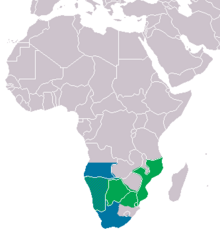Aspidelaps lubricus
| Cape coral snake Aspidelaps lubricus | |
|---|---|

| |
| Cape coral snake | |
| Scientific classification | |
| Kingdom: | |
| Phylum: | |
| Class: | |
| Order: | |
| Suborder: | |
| Family: | |
| Genus: | |
| Species: | A. lubricus
|
| Binomial name | |
| Aspidelaps lubricus | |

| |
| blue - range of A. lubricus green - range of A. scutatus | |
The cape coral snake (Aspidelaps lubricus) is a species of venomous elapid snake found in parts of southern Africa.[2] This snake is found in regions of the Karoo, Cape Province, and all the way up into Namibia. It mostly inhabits very arid regions, like deserts and rocky/sandy ecosystems. These areas within South Africa within the Karoo are known for low predictable rainfall and little vegetation, mostly shrubs and scrubs.[3]
Taxonomy
| Subspecies | Taxon author | Common name | Geographic range |
|---|---|---|---|
| A. l. lubricus | (Laurenti, 1768)[1] | Cape coral snake | Cape Province, Orange Free State (South Africa) |
| A. l. cowlesi | Bogert, 1940[1] | Angolan coral snake | Southern Angola, northern Namibia |
Description
Relatively small, slender bodied snake, around 1.6-2.0 feet long with some growing up to 2.5 feet in some cases. The snake is a small elapid, which means that it is a part of a group of venomous snakes that are usually found within tropical or sub-tropical regions around the globe. Along with its venom, the snake has an enlarged rostral scale, which is the scale located at the front of the snout above the mouth opening on the snake. The snakes head relative to its body is very short, making it very easy to distinguish it from the neck and rest of snake. The snake ranges in colors from red-orange to yellow, slightly resembling the coloration patterns seen on some species of Corn Snakes. The Coral Snake also contains thick black bars along the length of the body, fully encircling on the body while not fully on the tail segment. There are around 20-47 total bands spanning the length of the snakes body. This species also contains a narrow hood right below the head, similar to that of a cobra.[4]
Habitat
This species of snake is nocturnal, which means most of its activity and hunting occurs during the night. Since the snake generally prefers arid, rocky/sandy ecosystems, the snake will often be found living under rocks or even in underground burrows and tunnels. This snake has also been known to prefer leaving its burrow or hiding spots on cooler nights compared to the warmer nights in the summer.[5]
Diet
Since the snake is nocturnal, it relies on smell and taste to hunt its prey. This snake typically leaves its burrow or hole in search of smaller vertebrates nearby. It preys specifically on lizards, but has also been known to hunt vertebrates such as legless skinks, small rodents and sometimes other snakes. The snake is also known to target those vertebrates who are strictly diurnal, who are sleeping when it is on the hunt. This snake is known to rear up towards prey or when threatened and then strikes, injecting its venom. In captivity, these snakes are known to eat some types of fish, mice, small rats and also chicken legs, which are preferred by the juveniles.[3]
Reproduction and life cycles
Not much information was found on these snakes in the wild, however there is reproduction data from the snakes within captivity. In captivity, these snakes are known to be exceptionally easy to breed. The breeding period starts in the winter, with the cooling down of winter temperatures. The snakes then increase their uptake of food to help cope with the extra energy needed to reproduce. If the mating occurs at this time, then the eggs will usually lay in May or June. After that, there is a period of about 65 days before the eggs begin to hatch. There are usually between 3-11 eggs hatched per litter, with sometimes multiple litters per breeding period. When the babies hatch, they can be around 17-18 cm long.[3]
Venom
Although these snakes are held as pets within captivity, there is still little known information on the venom itself. There has been no information given about the toxicity or the composition of the venom. However, the venom has been noted as similar to the Naja genus, which contains all of the snakes known as cobras. When venom has been taken in captivity, it yields around 27-71 mg of wet venom. The average yield is around 55 mg and is about 28% solid material. Previous studies have shown that in rats, this snake’s venom caused neurological symptoms, which escalated into respiratory failure and eventually death.[3]
Conservation status
As of 2015, the Cape Coral Snake is not listed as threatened or in need of conservation efforts. The main threat that is listed for this species is when crossing roads and highways, where vehicles can run over them. [6]
References
- ^ a b c "Aspidelaps lubricus (Laurenti, 1768)". The Reptile Database. Retrieved 16 February 2012.
- ^ a b "Aspidelaps lubricus". ITIS Standard Report Page. Integrated Taxonomic Information System. www.itis.gov. Retrieved 16 February 2012.
- ^ a b c d van der Ploeg, Harold. "Aspidelaps lubricus". aspidelaps.eu.
- ^ "Branson's Wild World – Namibian Coral Cobra". Branson's Wild World.
- ^ "WCH Clinical Toxinology Resources". toxinology.com.
- ^ "SCARCE HOME". sun.ac.za.
Further reading
- Spawls, Stephen; Branch, Bill [in French] (1995). The Dangerous Snakes of Africa: Natural History, Species Directory, Venoms, and Snakebite. Dubai: Oriental Press: Ralph Curtis-Books. ISBN 0-88359-029-8.
External links
- "Aspidelaps lubricus - General Details, Taxonomy and Biology, Venom, Clinical Effects, Treatment, First Aid, Antivenoms". Clinical Toxinology Resource. University of Adelaide. Retrieved 16 February 2012.
